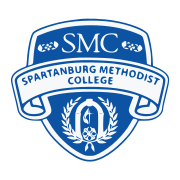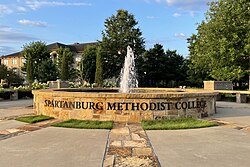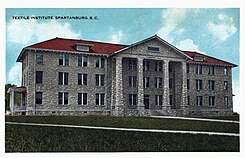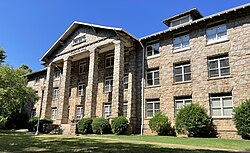Spartanburg Methodist College
Topic: Organization
 From HandWiki - Reading time: 8 min
From HandWiki - Reading time: 8 min
 | |
Former names | Textile Industrial Institute (1911–1942) Spartanburg Junior College (1942–1974) |
|---|---|
| Motto | Deus Providet (Latin) |
Motto in English | "God provides" |
| Type | Private college |
| Established | 1911 |
| Founder | David English Camak |
Religious affiliation | United Methodist Church |
| Endowment | $24.8 million (2022)[1] |
| President | William Scott Cochran |
Academic staff | 89 |
| Students | 1,025 |
| Location | Saxon (Spartanburg address) , South Carolina , United States [ ⚑ ] 34°57′13″N 81°58′16″W / 34.95361°N 81.97111°W |
| Campus | metropolitan, 110-acre (45 ha) campus |
| |u}}rs | Blue & white |
| Nickname | Pioneers |
| Mascot | Chuck |
| Website | www |
 | |
Spartanburg Methodist College (SMC) is a private Methodist college in Saxon, South Carolina. The college is affiliated with the United Methodist Church and has approximately 1,000 students (2022-2023 academic year).
History
Spartanburg Methodist College history dates back to its founding in 1911 as the Textile Industrial Institute (TII) by David English Camak. Camak was inspired by the challenges faced by southern cotton textile workers. With the support of Walter S. Montgomery, president of Spartan Mill, Camak established an elementary and secondary school in a vacant house near Duncan Memorial Methodist Episcopal Church. The school grew steadily, eventually becoming a mission of the South Carolina Conference of the Methodist Episcopal Church.[2]
Founding and early years (1911-1919)
In 1913, the college acquired its present campus and began the construction of Charles P. Hammond Hall. Hammond Hall played a significant role in accommodating students and fostering a sense of community on the campus, and serves as a residence hall to this day.
Even though the work and study schedules helped students to attend Textile Industrial Institute, the school needed additional income to operate and help realize Dr. Camak's dream. To obtain Camak’s dream into the real world, The TII Board of Trustees must recruit members from the South Carolina Methodist conferences, allow the land to be on sale, and pay off the debts to create new funds for the project. Camak's dream became a reality in 1919 with the opening of the Model Mill, providing TII the opportunity to combine education and work as Camak had envisioned. The Model Mill made pretty weaves, dyed and bleached materials, improved the threads to make them stronger, and perfected the art of depth in precise dying. The success of the Model Mill was short-lived. In 1921, the mill employed only TII students, but issues with financing led the Model Mill to close in 1922. Students once again returned to off-campus jobs to support them while enrolled at TII.[3]
Expansion and challenges (1920-1940)
By 1927, TII expanded its offerings to include the first two years of college-level education, providing students with various pathways for their future.[2] After initially providing high school-level courses for young adults working in the area's textile mills, TII expanded its curriculum in 1927 to offer two years of college-level work, granting associate degrees in liberal arts. That allowed graduates to transfer to senior-level colleges or enter the workforce with valuable skills.[2]
The college continued expanding as students' work and study schedules coordinated with their jobs, and more students got an education. The industrial mill jobs on campus created declines in health from working in rash conditions. Many students worked on the campus in the kitchen, laundry, or farm; others worked in town. With the increased enrollment, the trustees soon realized that extra housing would be needed. Eliza Attleton Judd, wife of a local bank president, was interested in helping women access education and offered a solution to the school's housing problem by donating money to create a building for girls on campus. The trustees believed that completing Hammond Hall was a more urgent priority than building a dormitory for girls. Mrs. Judd continued to support TII with a gift of timberland. In 1928, a decade after her death, the Textile Industrial Institute built Judd Hall, a women's dormitory, in her honor.[3]
In 1940, TII discontinued its high school classes, and in 1942, the institution changed its name to Spartanburg Junior College. In 1974, it changed its name to Spartanburg Methodist College.[2]
Transitioning to a four-year institution
For decades, Spartanburg Methodist College served as a two-year junior college.[4] In 2019, Spartanburg Methodist College further expanded its academic offerings by introducing bachelor's degree programs. Today, the college is a four-year institution.[5]
Presidents
| College presidents | |
|---|---|
| President | Years Served |
|
| |
| David English Camak | 1911-1923 |
| Rembert B. Burgess | 1923-1962 |
| Lester Kingman | 1963-1970 |
| James S. Barrett | 1970-1976 |
| George D. Fields, Jr. | 1976-1997 |
| Charles Porter Teague | 1997-2009 |
| Colleen Perry Keith | 2009-2015 |
| William Scott Cochran | 2015-present |

The university's current president, Scott Cochran, assumed office on November 16, 2015.[7][8] The president is appointed by the university's board of trustees, which has 24 members, five clergy and 19 laity, whose terms are staggered on a three-year basis.[9]
Accreditation and affiliations
Spartanburg Methodist College is accredited by the Southern Association of Colleges and Schools Commission on Colleges and the University Senate of the United Methodist Church. It is affiliated with the United Methodist Church and the South Carolina Annual Conference.
Academics
SMC offers six associate degree and five bachelor's degree programs. Bachelor's degrees are available in business administration, psychology, professional writing and digital communications, sports management, or a customizable degree where students can select two concentrations from a pool of six: business, criminal justice, English, history, psychology, and religion.
| Percentage | |
|---|---|
| White | 45.0 |
| African American | 36.0 |
| Hispanic | 12.0 |
| Asian | 1.0 |
| Non-resident | 1.0 |
| Multiracial or other | 6.0 |
Campus
SMC occupies 110 acres near the western edge of the city limits of Spartanburg. The campus has seven residential halls (Willard, Hammond, Kingman, Parsons, Judd, Bridges, and Sparrow) that are co-ed or all-female. Over the past decade, SMC has expanded its campus facilities. In 2012, a new academic building, Ellis Hall, was opened on campus. It houses nine classrooms, a bookstore, and academic offices, including the Vice President for Academic Affairs office, the Write Place, student publications, the President's Hall, and Gibbs Auditorium (which seats 275).[11] In 2019, the 4,000-square-foot Moore Family Fitness Center was opened on campus and provides students with access to aerobics machines, free weights, weight machines, and an aerobics classroom.
Athletics
The college is a Division I member of Region X of the National Junior College Athletic Association (NJCAA). Region X includes colleges in the Carolinas, West Virginia, and Virginia. SMC offers 14 intercollegiate athletic programs. Which include Men's and Women's Soccer, Men's and Women's Tennis, Men's and Women's Golf, Men's and Women's Basketball, Men's and Women's Cross Country, Softball, Volleyball (indoor and beach), Baseball, and Men's and Women's Track and Field. SMC also offers men's and women's track and field. SMC also offers men's and women's track and field. The college's athletic teams have won numerous regional, divisional, and national titles.
The men's soccer team won the 1994 NJCAA national championship. Several other teams have made appearances in their respective NJCAA (JUCO) Division I national tournaments in recent years. Most recently, women's golf (three individual Top 50 finishes, 2011), men's tennis (26th-place finish, 2010), wrestling (29th-place finish, 2010), men's cross-country (2nd place, 2012), women's cross-country (16th place, 2009), men's and women's half-marathon (3rd place, 2012), and volleyball (16th-place finish), 2009).
On October 2, 2023, it was announced that the Spartanburg Methodist College Pioneers would be joining the National Association of Intercollegiate Athletics (NAIA) as a member of the Continental Athletic Conference beginning with the 2024-25 athletics year.[12] The Pioneers previously competed in the NJCAA Region 10 until the 2023–24 school year.
Notable alumni
- Notable Spartanburg Methodist College alumni include:
Olin D. Johnston South Carolina Governor and Senator (first graduating class of the college)[13]
Orlando Hudson professional baseball player[14]
Lee Haney professional bodybuilder [15]
Heath Hembree professional baseball player[16]
Reggie Sanders professional baseball player[19]
Jerry Martin professional baseball player[20]
C. D. Pelham professional baseball player[21]
Vernon Taylor professional basketball player[22]
Harris Stanton comedian[23]
Sebastián Velásquez professional soccer player[24]
Zack Godley professional baseball player[25]
Dwight Smith professional baseball player[26]
References
- ↑ "U.S. and Canadian Institutions Listed by Fiscal Year (FY) 2022 Endowment Market Value and Change in Endowment Market Value from FY21 to FY22". National Association of College and University Business Officers. 2023. https://www.nacubo.org/-/media/Nacubo/Documents/research/2022-NTSE-Public-Tables--Endowment-Market-Values--FINAL.ashx?la=en&hash=362DC3F9BDEB1DF0C22B05D544AD24D1C44E318D. Retrieved October 3, 2023.
- ↑ 2.0 2.1 2.2 2.3 "Spartanburg Methodist College" (in en-US). https://www.scencyclopedia.org/sce/entries/spartanburg-methodist-college/.
- ↑ 3.0 3.1 Cann, Kathy (2007). Common Ties: a History of Textile Industrial Institute, Spartanburg Junior College, and Spartanburg Methodist College. Hub City Writers Project.
- ↑ Herald, Journal (1991-10-18). "SMC Trustees won't seek four-year status" (in en-US). https://www.goupstate.com/story/news/1991/10/18/smc-trustees-won39t-seek-four-year-status/29539710007/.
- ↑ Ware, Lisa (2019-02-20). "SMC receives federal approval to offer first four-year degree this fall" (in en-US). https://www.smcsc.edu/smc-receives-federal-approval-to-offer-first-four-year-degree-this-fall/.
- ↑ https://myatlascms.com/map/accessible.php?id=781&cId=20043&mId=186087
- ↑ "The Inauguration of W. Scott Cochran" (in en-US). https://www.smcsc.edu/article/inauguration-w-scott-cochran/.
- ↑ Writer, Staff. "SMC President Scott Cochran elected to NAICU board of directors" (in en-US). https://www.goupstate.com/story/news/education/2018/03/16/smc-president-scott-cochran-elected-to-naicu-board-of-directors/12975344007/.
- ↑ "Spartanburg Methodist College names three new trustees to board" (in en-US). 2023-08-18. https://scicu.org/spartanburg-methodist-college-names-three-new-trustees-to-board/.
- ↑ "College Navigator - Spartanburg Methodist College". https://nces.ed.gov/collegenavigator/?q=spartanburg+methodist&s=all&id=218821#enrolmt.
- ↑ Kitzmiller, Felicia. "Spartanburg Methodist celebrates opening of Ellis Hall" (in en-US). https://www.goupstate.com/story/news/2012/11/07/spartanburg-methodist-celebrates-opening-of-ellis-hall/30010603007/.
- ↑ "NAIA Announces Five New Members". National Association of Intercollegiate Athletics. 2 October 2023. https://www.naia.org/general/2023-24/releases/NAIA_NewMembersFall_10_2_2023.
- ↑ "Olin DeWitt Talmadge Johnston | 2004 Hall of Fame | Anderson County Museum". https://andersoncountymuseum.sc.gov/olin-dewitt-talmadge-johnston-2004-hall-fame.
- ↑ "Orlando Hudson Stats". Baseball Almanac. http://www.baseball-almanac.com/players/player.php?p=hudsoor01.
- ↑ "Lee Haney Pro Bodybuilding Profile". 12 October 2015. https://www.bodybuilding.com/fun/bodybuilders-haney.htm.
- ↑ "Heath Hembree - Baseball" (in en). https://cofcsports.com/sports/baseball/roster/heath-hembree/2633.
- ↑ "Spartanburg Methodist College Baseball Players Who Made it to a Major League Baseball Team | Baseball Almanac". https://www.baseball-almanac.com/college/spartanburg_methodist_college_baseball_players.shtml.
- ↑ Ware, Lisa (2014-10-14). "NY Mets Hall of Famer Mookie Wilson to headline SMC Founder's Day Program" (in en-US). https://www.smcsc.edu/ny-mets-hall-famer-mookie-wilson-headline-smc-founders-day-program/.
- ↑ "Reggie Sanders Stats". Baseball Almanac. http://www.baseball-almanac.com/players/player.php?p=sandere02.
- ↑ "Jerry Martin - Baseball Stats - The Baseball Cube" (in en). https://www.thebaseballcube.com/content/player/14816/.
- ↑ Shanesy, Todd. "SMC alum Pelham gets the call from Rangers" (in en-US). https://www.goupstate.com/story/sports/mlb/2018/09/04/smc-alum-cd-pelham-gets-call-from-rangers/10857729007/.
- ↑ "Team compleet met komst Vernon Taylor" (in nl). https://www.donar.nl/nieuws/team-compleet-met-komst-vernon-taylor.
- ↑ "Harris Stanton | Comedians" (in en). https://thestandnyc.com/comedians/harris-stanton.
- ↑ "Sebastián Velásquez". Real Salt Lake. http://www.realsaltlake.com/players/sebastian-velasquez.
- ↑ "Former SMC pitcher baffles Brewers in D-Backs debut" (in en-US). https://www.goupstate.com/story/news/2015/07/24/former-smc-pitcher-baffles-brewers-in-d-backs-debut/30093426007/.
- ↑ "Dwight Smith Stats". Baseball Almanac. http://www.baseball-almanac.com/players/player.php?p=smithdw01.
External links
[ ⚑ ] 34°57′13″N 81°58′16″W / 34.9535067°N 81.9712091°W
 |
 KSF
KSF














